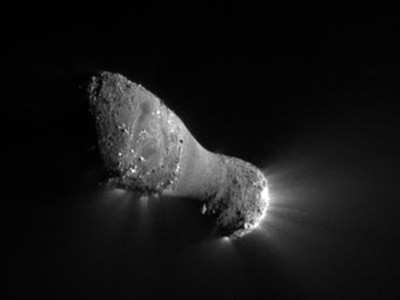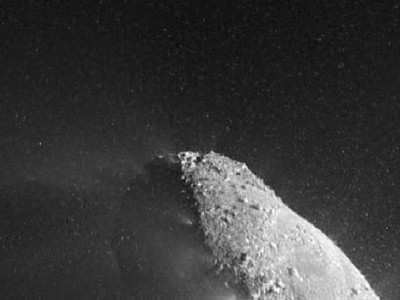First Time To See Individual Ice Chunks In Comet Cloud
 The EPOXI mission's recent encounter with comet Hartley 2
provided the first images clear enough for scientists to link jets
of dust and gas with specific surface features. NASA and other
scientists have begun to analyze the images.
The EPOXI mission's recent encounter with comet Hartley 2
provided the first images clear enough for scientists to link jets
of dust and gas with specific surface features. NASA and other
scientists have begun to analyze the images.
The EPOXI spacecraft revealed a cometary snow storm created by
carbon dioxide jets spewing out tons of golf-ball to
basketball-sized fluffy ice particles from the peanut-shaped
comet's rocky ends. At the same time, a different process was
causing water vapor to escape from the comet's smooth mid-section.
This information sheds new light on the nature of comets and even
planets.
Scientists compared the new data to data from a comet the
spacecraft previously visited that was somewhat different from
Hartley 2. In 2005, the spacecraft successfully released an
impactor into the path of comet Tempel 1, while observing it during
a flyby.
"This is the first time we've ever seen individual chunks of ice
in the cloud around a comet or jets definitively powered by carbon
dioxide gas," said Michael A'Hearn, principal investigator for the
spacecraft at the University of Maryland. "We looked for, but
didn't see, such ice particles around comet Tempel 1."

NASA Image Hartley 2 Comet
The new findings show Hartley 2 acts differently than Tempel 1
or the three other comets with nuclei imaged by spacecraft. Carbon
dioxide appears to be a key to understanding Hartley 2 and explains
why the smooth and rough areas scientists saw respond differently
to solar heating, and have different mechanisms by which water
escapes from the comet's interior.
"When we first saw all the specks surrounding the nucleus, our
mouths dropped," said Pete Schultz, EPOXI mission co-investigator
at Brown University. "Stereo images reveal there are snowballs in
front and behind the nucleus, making it look like a scene in one of
those crystal snow globes."
Data show the smooth area of comet Hartley 2 looks and behaves
like most of the surface of comet Tempel 1, with water evaporating
below the surface and percolating out through the dust. However,
the rough areas of Hartley 2, with carbon dioxide jets spraying out
ice particles, are very different.

NASA Image Hartley 2 Comet
"The carbon dioxide jets blast out water ice from specific
locations in the rough areas resulting in a cloud of ice and snow,"
said Jessica Sunshine, EPOXI deputy principal investigator at the
University of Maryland. "Underneath the smooth middle area, water
ice turns into water vapor that flows through the porous material,
with the result that close to the comet in this area we see a lot
of water vapor."
Engineers at NASA's Jet Propulsion Laboratory in Pasadena, CA,
have been looking for signs ice particles peppered the spacecraft.
So far they found nine times when particles, estimated to weigh
slightly less than the mass of a snowflake, might have hit the
spacecraft but did not damage it.
"The EPOXI mission spacecraft sailed through the Hartley 2's ice
flurries in fine working order and continues to take images as
planned of this amazing comet," said Tim Larson, EPOXI project
manager at JPL.
Scientists will need more detailed analysis to determine how
long this snow storm has been active, and whether the differences
in activity between the middle and ends of the comet are the result
of how it formed some 4.5 billion years ago or are because of more
recent evolutionary effects.

NASA Image Hartley 2 Comet
EPOXI is a combination of the names for the mission's two
components: the Extrasolar Planet Observations and Characterization
(EPOCh), and the flyby of comet Hartley 2, called the Deep Impact
Extended Investigation (DIXI).
JPL manages the EPOXI mission for the Science Mission
Directorate at NASA Headquarters in Washington. The spacecraft was
built for NASA by Ball Aerospace & Technologies Corp., in
Boulder, Colo.
 ANN's Daily Aero-Linx (06.29.25)
ANN's Daily Aero-Linx (06.29.25) ANN's Daily Aero-Term (06.29.25): Gross Navigation Error (GNE)
ANN's Daily Aero-Term (06.29.25): Gross Navigation Error (GNE) Classic Aero-TV: Anticipating Futurespace - Blue Origin Visits Airventure 2017
Classic Aero-TV: Anticipating Futurespace - Blue Origin Visits Airventure 2017 NTSB Final Report: Cirrus SR22
NTSB Final Report: Cirrus SR22 Airborne Affordable Flyers 06.26.25: PA18 Upgrades, Delta Force, Rhinebeck
Airborne Affordable Flyers 06.26.25: PA18 Upgrades, Delta Force, Rhinebeck






